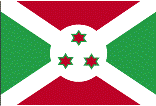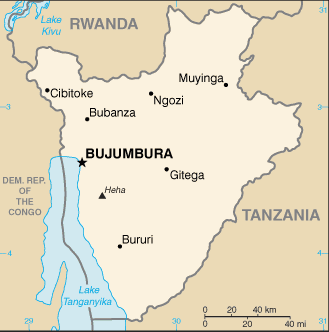|
Burundi
|

|
Capital: Bujumbura
Population: 10,864,245
Brief History of Burundi:
Starting in the 1500s Burundi was ruled by a king called the mwani. The Mwani ruled and owned all the land of the country. Farmers would work the land and pay the king a tax or tribute. The king would provide protection.The first Europeans arrived in Burundi in 1856. At this time they did not stay. It wasn't until 1899 that Germany took control of Burundi. Later, in 1916 Belgium took over the territory. There were two major political parties in Burundi including the Union for National Progress (UPRONA) and the Christian Democratic Party (PDC).
Burundi became independent on July 1, 1962. At first it was a constitutional democracy let by King Mwambutsa IV. The country was very unstable, however, as military leaders struggled for power. The country continued to get worse and in the 1990s was plunged into a terrible civil war between two ethnic groups, the Hutus and the Tutsi. The civil war ended in 2006 with over 150,000 people killed.
The Geography of Burundi
Total Size: 27,830 square km
Size Comparison: slightly smaller than Maryland
Geographical Coordinates: 3 30 S, 30 00 E
World Region or Continent: Africa
General Terrain: hilly and mountainous, dropping to a plateau in east, some plains
Geographical Low Point: Lake Tanganyika 772 m
Geographical High Point: Heha 2,670 m
Climate: equatorial; high plateau with considerable altitude variation (772 m to 2,670 m above sea level); average annual temperature varies with altitude from 23 to 17 degrees centigrade but is generally moderate as the average altitude is about 1,700 m; average annual rainfall is about 150 cm; two wet seasons (February to May and September to November), and two dry seasons (June to August and December to January)
Major cities: BUJUMBURA (capital) 455,000 (2009)
The People of Burundi
Type of Government: republic
Languages Spoken: Kirundi (official), French (official), Swahili (along Lake Tanganyika and in the Bujumbura area)
Independence: 1 July 1962 (from UN trusteeship under Belgian administration)
National Holiday: Independence Day, 1 July (1962)
Nationality: Burundian(s)
Religions: Christian 67% (Roman Catholic 62%, Protestant 5%), indigenous beliefs 23%, Muslim 10%
National Symbol: lion
National Anthem or Song: Burundi Bwacu (Our Beloved Burundi)
Economy of Burundi
Major Industries: light consumer goods such as blankets, shoes, soap; assembly of imported components; public works construction; food processing
Agricultural Products: coffee, cotton, tea, corn, sorghum, sweet potatoes, bananas, manioc (tapioca); beef, milk, hides
Natural Resources: nickel, uranium, rare earth oxides, peat, cobalt, copper, platinum, vanadium, arable land, hydropower, niobium, tantalum, gold, tin, tungsten, kaolin, limestone
Major Exports: coffee, tea, sugar, cotton, hides
Major Imports: capital goods, petroleum products, foodstuffs
Currency: Burundi franc (BIF)
National GDP: $5,184,000,000
** Source for population (2012 est.) and GDP (2011 est.) is CIA World Factbook.
Back to Geography Home Page
